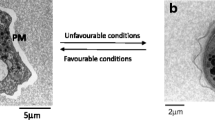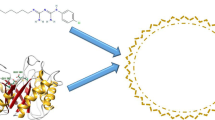Abstract
The free living Acanthamoeba spp. are ubiquitous amoebae associated with potentially blinding disease known as Acanthamoeba keratitis (AK) and a fatal central nervous system infection granulomatous amoebic encephalitis (GAE). With the inherent ability of cellular differentiation, it can phenotypically transform to a dormant cyst form from an active trophozoite form. Acanthamoeba cysts are highly resistant to therapeutic agents as well as contact lens cleaning solutions. One way to tackle drug resistance against Acanthamoeba is by inhibiting the formation of cysts from trophozoites. The biochemical analysis showed that the major component of Acanthamoeba cyst wall is composed of carbohydrate moieties such as galactose and glucose. The disaccharide of galactose and glucose is lactose. In this study, we analyzed the potential of lactase enzyme to target carbohydrate moieties of cyst walls. Amoebicidal assessment showed that lactase was ineffective against trophozoite of A. castellanii but enhanced amoebicidal effects of chlorhexidine. The lactase enzyme did not show any toxicity against normal human keratinocyte cells (HaCaT) at the tested range. Hence, lactase can be used for further assessment for development of potential therapeutic agents in the management of Acanthamoeba infection as well as formulation of effective contact lens disinfectants.




Similar content being viewed by others
Data availability
The data is available upon request to the author.
References
Abjani F, Khan NA, Yousuf FA, Siddiqui R (2016) Targeting cyst wall is an effective strategy in improving the efficacy of marketed contact lens disinfecting solutions against Acanthamoeba castellanii cysts. Cont Lens Anterior Eye 39(3):239–243
Ahmed U, Anwar A, Ong SK, Anwar A, Khan NA (2022a) Applications of medicinal chemistry for drug discovery against Acanthamoeba infections. Med Res Rev 42(1):462–512
Ahmed U, Ho KY, Simon SE, Saad SM, Ong SK, Anwar A, Tan KO, Sridewi N, Khan KM, Khan NA, Anwar A (2022b) Potential anti-acanthamoebic effects through inhibition of CYP51 by novel quinazolinones. Acta Trop 231:106440
Ahmed U, Manzoor M, Qureshi S, Mazhar M, Fatima A, Aurangzeb S, Hamid M, Khan KM, Khan NA, Rashid Y, Anwar A (2023) Anti-amoebic effects of synthetic acridine-9 (10H)-one against brain-eating amoebae. Acta Trop 239:106824
Aksozek A, McClellan K, Howard K, Niederkorn JY, Alizadeh H (2002) Resistance of Acanthamoeba castellanii cysts to physical, chemical, and radiological conditions. J Parasitol 88(3):621–623
Anwar A, Khan NA, Siddiqui R (2018) Combating Acanthamoeba spp. cysts: what are the options? Parasit Vectors 11(1):1–6
Anwar A, Mungroo MR, Anwar A, Sullivan WJ Jr, Khan NA, Siddiqui R (2019a) Repositioning of guanabenz in conjugation with gold and silver nanoparticles against pathogenic amoebae Acanthamoeba castellanii and Naegleria fowleri. ACS Infect Dis 5(12):2039–2046
Anwar A, Khan NA, Siddiqui R (2019b) Galactose as novel target against Acanthamoeba cysts. PLoS Negl Trop Dis 13(7):e0007385
Baig AM, Khaleeq A (2020) First reports of effects of insulin, human-like insulin receptors and adapter proteins in Acanthamoeba castellanii. Sci Rep 10(1):1–4
Bowers B, Korn ED (1969) The fine structure of Acanthamoeba castellanii (Neff strain) II. Encystment, J Cell Bio 41(3):786–805
Chávez-Munguía B, Omaña-Molina M, González-Lázaro M, González-Robles A, Bonilla P, Martínez-Palomo A (2005) Ultrastructural study of encystation and excystation in Acanthamoeba castellanii. J Eukaryot Microbiol 52(2):153–158
Dart JK, Saw VP, Kilvington S (2009) Acanthamoeba keratitis: diagnosis and treatment update 2009. Am J Ophthalmol 148(4):487–499
Dudley R, Alsam S, Khan NA (2007) Cellulose biosynthesis pathway is a potential target in the improved treatment of Acanthamoeba keratitis. Appl Microbiol Biotechnol 75(1):133–140
Dudley R, Jarroll EL, Khan NA (2009) Carbohydrate analysis of Acanthamoeba castellanii. Exp Parasitol 122(4):338–343
Forsgård RA (2019) Lactose digestion in humans: intestinal lactase appears to be constitutive whereas the colonic microbiome is adaptable. Am J Clin Nutr 110(2):273–279
Gooi P, Lee-Wing M, Brownstein S, El-Defrawy S, Jackson WB, Mintsioulis G (2008) Acanthamoeba keratitis: persistent organisms without inflammation after 1 year of topical chlorhexidine. Cornea 27(2):246–248
Gurung N, Ray S, Bose S, Rai V (2013) A broader view: microbial enzymes and their relevance in industries, medicine, and beyond. Biomed Res Int 2013:329121
Hirukawa Y, Nakato H, Izumi S, Tsuruhara T, Tomino S (1998) Structure and expression of a cyst specific protein of Acanthamoeba castellanii. Biochim Biophys Acta (BBA)-Gene Struct Expr 1398(1):47–56
Khan NA (2003) Pathogenesis of Acanthamoeba infections. Microb Pathog 34(6):277–285
Kulsoom H, Baig AM, Siddiqui R, Khan NA (2014) Combined drug therapy in the management of granulomatous amoebic encephalitis due to Acanthamoeba spp., and Balamuthia mandrillaris. Exp Parasitol 145:S115-20
Lazuana T, Astuty H, Sari IP (2019) Effect of cellulase enzyme treatment on cyst wall degradation of Acanthamoeba sp. J Parasitol Res 2019:8915314. https://doi.org/10.1155/2019/8915314
Lloyd D, Turner NA, Khunkitti W, Hann AC, Furr JR, Russell AD (2001) Encystation in Acanthamoeba castellanii: development of Biocide Resistance. J Eukaryot Microbiol 48(1):11–16
Lorenzo-Morales J, Kliescikova J, Martinez-Carretero E, De Pablos LM, Profotova B, Nohynkova E, Osuna A, Valladares B (2008) Glycogen phosphorylase in Acanthamoeba spp.: determining the role of the enzyme during the encystment process using RNA interference. Eukaryot Cell 7(3):509–517
Marciano-Cabral F, Puffenbarger R, Cabral GA (2000) The increasing importance of Acanthamoeba infections. J Eukaryot Microbiol 47(1):29–36
Martinez AJ (1985) Free-living amebas: natural history, prevention, diagnosis, pathology, and treatment of disease. CRC Press; Boca Raton, FL, pp 5–42
Neff RJ, Neff RH (1969) The biochemistry of amoebic encystment, In Symposia of the Society for Exp. Biology 23:51–81
Siddiqui R, Khan NA (2012) Biology and pathogenesis of Acanthamoeba. Parasit Vectors 5(1):1–3
Stapleton F, Carnt N (2012) Contact lens-related microbial keratitis: how have epidemiology and genetics helped us with pathogenesis and prophylaxis. Eye 26:185–193
Teknos TN, Poulin MD, Laruentano AM, Li KK (2000) Acanthamoeba rhinosinusitis: charactetization, diagnosis, and treatment. Am J Rhinol 14(6):387–392
Wang Z, Wu D, Tachibana H, Feng M, Cheng XJ (2020) Identification and biochemical characterisation of Acanthamoeba castellanii cysteine protease 3. Parasit Vectors 13(1):592
Weisman RA (1976) Differentiation in Acanthamoeba castellanii. Annu Rev Microbiol 30(1):189–219
Wiley CA, Safrin RE, Davis CE, Lampert PW, Braude AI, Martinez AJ, Visvesvara GS (1987) Acanthamoeba meningoencephalitis in a patient with AIDS. J Infect Dis 155(1):130–133
Funding
The authors acknowledge the financial support of Sunway University, Malaysia (Internal Grant Scheme 2022), GRTIN-IGS(02)-DBS-10–2022. Ruqaiyyah Siddiqui and Naveed Ahmed Khan are supported by the Air Force Office of Scientific Research (AFOSR), USA.
Author information
Authors and Affiliations
Contributions
AA and NAK conceptualized the study amid discussions with KMK and RS. FAS and UA carried out all experimental work amid critical discussions with NAK, AMA, HF, and AA. FAS, AA, and UA prepared the first draft, while KMK, RS, HF, AMA, and NAK corrected and finalized the manuscript. All authors approved the final manuscript.
Corresponding authors
Ethics declarations
Ethics approval
Not applicable.
Consent to participate
Not applicable.
Consent for publication
Not applicable.
Competing interests
The authors declare no competing interests.
Additional information
Section Editor: Sutherland Maciver.
Publisher's Note
Springer Nature remains neutral with regard to jurisdictional claims in published maps and institutional affiliations.
Fathimath Afaaf Simau and Usman Ahmed contributed equally.
Rights and permissions
Springer Nature or its licensor (e.g. a society or other partner) holds exclusive rights to this article under a publishing agreement with the author(s) or other rightsholder(s); author self-archiving of the accepted manuscript version of this article is solely governed by the terms of such publishing agreement and applicable law.
About this article
Cite this article
Simau, F.A., Ahmed, U., Khan, K.M. et al. Lactase can target cellular differentiation of Acanthamoeba castellanii belonging to the T4 genotype. Parasitol Res 123, 117 (2024). https://doi.org/10.1007/s00436-024-08131-2
Received:
Accepted:
Published:
DOI: https://doi.org/10.1007/s00436-024-08131-2




